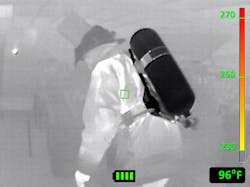Utilizing a TIC for Rapid Egress in Fireground Emergencies
Key Highlights
- A firefighting standard procedure for rapid egress from the interior of a structure fire might be to follow a hoseline. A hoseline might stand out from other room contents and fixtures and should be easy to identify with a thermal imager (TIC) because of its size and distinctive shape.
- Initially, when using the TIC on the interior of a structure fire, you can avoid hazards, locate a wall to follow, and identify doors and windows.
- Heavy concentrations of smoke might be able to be identified with a TIC because of the large particulates of soot and ash that are suspended in the convection flow, but the actual temperature that the smoke represents might not.
During interior structural firefighting, firefighters might need to reorient themselves within a building for several reasons, including separation from crew members, disorientation or becoming lost. Situations also might arise that require locating an alternative exit route, such as evacuating a casualty via the quickest means possible, an exit being blocked or withdrawing from an immediately dangerous to life and health environment.
Sensory inputs, such as available visual sight, auditory cues and tactile feedback, combined with previous and ongoing evaluation with the thermal imaging camera (TIC), can improve one’s familiarization with the building layout and features. This enhances situational awareness, visual memory and cognitive (mental) mapping of the environment, including position relative to objects and other people. It also aids in assessing conditions, identifying hazards and potential threats, and anticipating or interpreting changes in the environment.
Training and experience are critical in supporting effective decision-making, communicating observed hazards, maintaining orientation and navigating complex interiors. These help to reduce the likelihood of becoming separated or lost and improve the ability to respond rapidly to developing threats or the need for urgent evacuation.
Using a TIC when lost or to rapidly exit a building
Fire condition, other firefighters and objects are visible using the TIC in a search and rescue mode. The use of a TIC can reduce significantly the time that’s needed to reorient or exit a structure during an emergency. Always follow your agency’s standard operating procedures and emergency protocols.
In situations in which a firefighter becomes disoriented or separated from the crew or requires a rapid self-rescue, standard emergency procedures and using a TIC can help to achieve a safer, faster and more effective outcome. Rescanning the room or surrounding area with the TIC immediately might confirm previous observations or reveal new critical information that guides movement and decision-making.
Types of TICs include tactical (decision-making) models that are used by a crew and smaller, personal situational-awareness versions. Many organizations issue the latter to individual firefighters. Although some situational-awareness TICs might lack the features of full-size decision-making models, they can be invaluable in scenarios where the primary TIC is unavailable, such as when a firefighter is lost or separated. These TICs provide essential information and support orientation, navigation and hazard detection when time is critical.
Locating other crewmembers
When crewmembers become separated during interior operations, a TIC, along with conventional search methods, can be used to help to locate them. This includes rescanning the area with the TIC, calling out and visually searching below the smoke layer with a flashlight.
You must consider situations with low thermal contrast of people and background objects in spaces, particularly in cooler-temperature areas that are away from the main fire and lower areas, such as the floor level. In such environments, distinguishing a firefighter’s thermal signature can be challenging. A reliable cue in these situations is the distinctive shape and thermal contrast of an SCBA cylinder. It typically appears cooler than both the wearer and surroundings, to create a noticeable silhouette on the TIC display. The shape and contrast of the operating SCBA stands out against the background.
Another consideration is the TIC’s dynamic range in a hot environment, particularly when identifying objects, such as people. Some TICs have a good dynamic range, being capable of displaying a reasonable image of both very hot and cooler objects within the same field of view (FOV). However, high energy from fire might dominate the FOV, or the TIC might be oversaturated with color. Keeping the FOV low or away from high energy can maintain the camera in the “high sensitivity” range, or “gain” for some models. This might improve the lower-temperature contrast and details of the displayed image. Although TiBasic is the default operating mode, some TICs have a “cold spot tracker” or specific modes for search and rescue or fire to optimize the image within a structure fire environment. Refer to the manufacturer’s instructions and guidelines for use.
Thermal inversion refers to an object that changed screen shade compared with the background energy, even though its actual temperature didn’t. Although a person might appear warmer than the surroundings in a cold environment, in a hot area, that individual might appear cooler, even though the actual temperature of the person might not have altered significantly. Always identify people based on their shape, understanding that the grayscale shade in which they appear on the screen depends on not only the energy from the person but also background energy.
Locating and following the hoseline or guideline out
A firefighting standard procedure might be to follow a hoseline or guideline/search rope, if it’s in use. If detached from a guideline, it might be difficult to locate using the TIC because of the guideline’s size and low contrast with its background. Combining the use of the TIC with a hand search might be more effective for locating the guideline.
By comparison, a hoseline might stand out from other room contents and fixtures and should be easy to identify with the TIC because of its size and distinctive shape. The hose also normally might have high thermal contrast with other objects on the floor. The firefighter can locate the hose and follow it using standard procedures.
Locating alternative exits
During the scan of each new room that’s entered, a note of the room’s shape, size and layout, including the location of doors and windows that could be used as an alternative exit from the building, should be made to maintain situational awareness and “mind mapping.” The distinctive shape of a hoseline is visible using a situational-awareness TIC.
Initially, when using the TIC, you can avoid hazards, locate a wall to follow, and identify doors and windows. If an exit is blocked, that’s between furniture and other items might be located quickly to improve egress in the room. Windows and doorways often are easier to identify because of their distinctive shape and contrast with walls and other surface materials. Furthermore, the surrounding clutter of furniture and other objects in the room can be identified, which helps to determine the most efficient path to reach the window, if required.
When approaching a door, the TIC can assist in identifying potential high heat levels that are behind it. When opening a door, the TIC should allow quick observation of fire conditions and to scan and navigate to the next point. This also can include identifying whether the door is opening into a room without further egress—for example, a bathroom or walk-in closet. If trapped in a room that has a frame construction and drywall, if the intention is to breach a wall into an adjoining room, the TIC might assist in choosing access and a location to avoid solid materials. For this application, the absence of windows also might indicate interior walls.
Identifying and avoiding hazards
Because a TIC provides a two-dimensional view with limited depth perception and a narrow FOV compared with normal vision, some hazards might be difficult to identify. Examples include variations in floor levels, such as stairs, and loading bays in commercial buildings.
Fire conditions above ceilings and below floors might be difficult to identify because of the insulating properties of building components. Holes in floors and other hazards also might be difficult to locate. Care should be taken. Utilize sensory information, such as what you can feel, hear and see.
Avoiding areas of high temperature and convection flow paths
Although surface energy might be indicated as apparent temperatures in shades of gray and screen colorization, in some cases, convection energy might not be indicated accurately unless it has warmed surfaces. Heavy concentrations of smoke might be able to be identified with large particulates of soot and ash suspended in the convection flow, but the actual temperature that it represents might not.
By identifying the flow path of combustion gases, you also might be able to assess fire conditions. It also might enable you to identify positions of actual and potential convection flow paths, such as the likely flow, to avoid. In some cases, movement a short distance away might provide fire crews with a safe position to extinguish the fire from, to shelter or to seek an alternative safe exit from the environment. This can include isolation from high heat by closing doors.
Can’t be your only means of escape
Typically, a qualitative method of thermal imaging using grayscale and color matched to the TIC screen’s heat color reference bar or temperature scale is employed. This provides an immediate and obvious indication of details and high heat rather than using numeric values with temperature measurement. The use of direct temperature measurement should be avoided during an active structure fire.
Water sprays and environmental conditions, such as heavy smoke, soot and steam, can result in contaminants on the lens, screen and facemask. This will degrade image quality and the view of the screen, requiring cleaning as needed.
The use of thermal imaging provides additional information that must be interpreted by the operator. It must be remembered that many limitations exist; some objects and hazards might be difficult to identify.
During firefighting operations, always maintain situational awareness, utilize other sensory inputs, and identify potential exit points and objects that will assist you in exiting a building. Practice these skills in a training environment with and without a TIC, including other standard practices, such as mayday and self-rescue procedures. Although unlikely, TICs, like any item of equipment, can fail. Use the TIC but don’t rely on it as your only means of escape.
About the Author

Gavin Parker
Gavin Parker has been a career firefighter for 30 years in Australia. He has undertaken study with fire services and organizations in the United States and Canada on two occasions and an operational deployment to wildfires in California in 2017.
